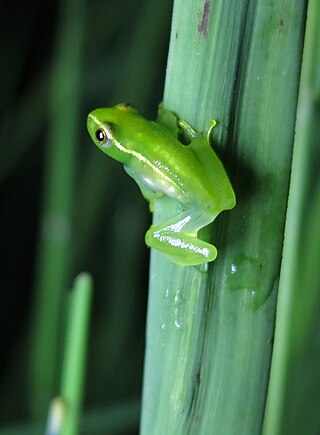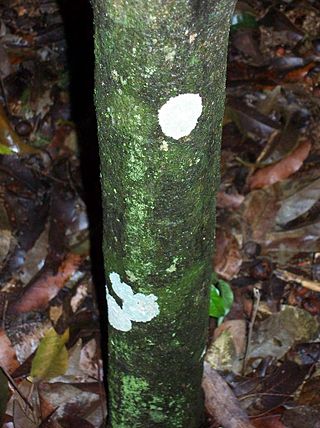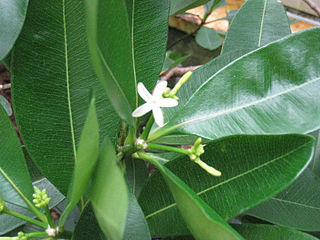
Sclerophrys poweri is a species of toad in the family Bufonidae. It is found in extreme southern Angola, northern Namibia, Botswana, southward to central South Africa, and Zambia. The specific name poweri honours John Hyacinth Power, Irish-born director of the McGregor Museum who collected amphibians as well as reptiles and plants.

Hyperolius poweri is a species of frogs in the family Hyperoliidae. It is found in southeastern coast of South Africa and southern Mozambique. The specific name poweri honours John Hyacinth Power, Irish-born director of the McGregor Museum who collected amphibians as well as reptiles and plants. Accordingly, common names Power's reed frog and Power's long reed frog have been proposed for this species.

Breviceps poweri, the Power's rain frog or Power's short-headed frog, is a species of frog in the family Brevicipitidae. It is found in northeastern Angola east through Zambia, southern Democratic Republic of the Congo, and Malawi, to western Mozambique and northeastern Zimbabwe; possibly in Namibia. The specific name poweri honours John Hyacinth Power, Irish-born director of the McGregor Museum who collected amphibians as well as reptiles and plants.
Dupontia poweri is a species of small air-breathing land snail, terrestrial pulmonate gastropod mollusk in the family Euconulidae, the hive snails. This species is endemic to Mauritius.
Ochrosia brevituba, synonym Neisosperma brevituba, is a species of plant in the family Apocynaceae. It is endemic to New Caledonia.

Ochrosia borbonica is a species of plant in the family Apocynaceae. It is native to Mauritius and Réunion, and naturalized in Guangdong Province in China.

Ochrosia is a genus of flowering plants, first described in 1789. It is in the family Apocynaceae, native to Southeast Asia, Australia, and various islands of the Indian and Pacific Oceans.
- Ochrosia ackeringae(Teijsm. & Binn.) Miq. – Indonesia, Philippines, Papuasia, Christmas Island
- Ochrosia acuminataTrimen ex Valeton – Sulawesi
- Ochrosia alyxioidesGuillaumin – Vanuatu
- Ochrosia apoensisElmer – Luzon, Mindanao
- Ochrosia balansae(Guillaumin) Baill. ex Guillaumin – New Caledonia
- Ochrosia basistaminaHendrian – Sulawesi
- Ochrosia bodenheimarumGuillaumin – Vallée de la Toutouta in New Caledonia
- Ochrosia borbonicaJ.F.Gmel. – Mauritius + Réunion; naturalized in Guangdong
- Ochrosia brevitubaBoiteau – New Caledonia
- Ochrosia brownii(Fosberg & Sachet) Lorence & Butaud – Nuku Hiva in Marquesas
- Ochrosia citrodoraK.Schum. & Lauterb. – New Guinea
- Ochrosia coccinea(Teijsm. & Binn.) Miq. – Maluku, Sulawesi, New Guinea, Solomon Islands; naturalized in Guangdong
- Ochrosia comptaK.Schum., Hōlei – Hawaii
- Ochrosia ellipticaLabill. – Lord Howe Island, Queensland, New Caledonia, Vanuatu, Nauru; naturalized in Guangdong + Taiwan
- Ochrosia fatuhivensisFosberg & Sachet – Fatu Hiva in Marquesas but extinct
- Ochrosia ficifolia(S.Moore) Markgr. – New Guinea
- Ochrosia glomerata(Blume) F.Muell. – Borneo, Sulawesi, Philippines, Maluku, New Guinea, Solomon Islands
- Ochrosia grandifloraBoit. – New Caledonia
- Ochrosia haleakalaeH.St.John, Hōlei – Maui + island of Hawaiʻi in Hawaiian Islands
- Ochrosia hexandraKoidz. – Kazan-retto
- Ochrosia inventorumL.Allorge – New Caledonia
- Ochrosia iwasakiana(Koidz.) Koidz. ex Masam.
- Ochrosia kauaiensisH.St.John, Hōlei – Kauaʻi in Hawaiian Islands
- †Ochrosia kilaueaensisH.St.John, Hōlei – island of Hawaiʻi in Hawaiian Islands, but extinct
- Ochrosia kilneriF.Muell. – Queensland
- Ochrosia lifuanaGuillaumin – Loyalty Islands + Isle of Pines in New Caledonia
- Ochrosia mariannensisA.DC. – Mariana Islands
- Ochrosia mianaBaill. ex Guillaumin – New Caledonia
- Ochrosia minima(Markgr.) Fosberg & Boiteau – Queensland, Papua New Guinea
- Ochrosia moorei(F.Muell.) F.Muell. ex Benth. – Queensland, New South Wales
- Ochrosia mulsantiiMontrouz. – New Caledonia
- Ochrosia nakaiana(Koidz.) Koidz. ex H.Hara – Ogasawara-shoto
- Ochrosia newellianaF.M.Bailey – Queensland
- Ochrosia novocaledonicaDäniker – New Caledonia
- Ochrosia oppositifolia(Lam.) K.Schum. – Seychelles, Chagos Islands, Sri Lanka, Maldive Islands, Andaman & Nicobar Islands, Thailand, Vietnam, W Malaysia, Indonesia, Papuasia, Samoa, Tonga, Tuvalu, Vanuatu, Wallis & Futuna, French Polynesia, Line Islands, Micronesia
- Ochrosia poweriF.M.Bailey – Queensland, New South Wales
- Ochrosia sciadophyllaMarkgr – Bismarck Archipelago, Solomon Islands
- Ochrosia sevenetiiBoiteau – New Guinea
- Ochrosia silvaticaDäniker – New Caledonia
- Ochrosia solomonensis(Merr. & L.M.Perry) Fosberg & Boiteau – Solomon Islands
- Ochrosia syncarpaMarkgr. – Bali, Lombok, Timor, Flores
- Ochrosia tahitensisLaness. ex Pichon – Tahiti
- Ochrosia tenimberensisMarkgr. – Tanimbar Islands
- Ochrosia nukuhivensisFosberg & Sachet = Rauvolfia nukuhivensis(Fosberg & Sachet) Lorence & Butaud
- Ochrosia sandwicensisA.DC. = Rauvolfia sandwicensisA.DC.
- Ochrosia tuberculata(Vahl) Pichon = Rauvolfia sandwicensisA.DC.

Ochrosia grandiflora is a species of plant in the family Apocynaceae. It is endemic to New Caledonia. It is threatened by habitat loss.

Ochrosia haleakalae, the island yellowwood or hōlei, is a species of plant in the family Apocynaceae that is endemic to Hawaiʻi. It is threatened by habitat loss.

Ochrosia kauaiensis, the Kauai yellowwood, is a species of plant in the family Apocynaceae. It is endemic to the island of Kauai in Hawaii. It is threatened by habitat loss.
Ochrosia kilaueaensis is an extinct species of flowering plant in the genus Ochrosia in Apocynaceae. Its common names include holei and Hawaii yellowwood. It was endemic to the island of Hawaiʻi. It has been collected only at Puuwaawaa and Kipuka Puaulu and has not been seen since the 1940s.
Ochrosia tahitensis was a species of plant in the family Apocynaceae. It is endemic to Tahiti of the Society Islands, in French Polynesia.
John Hyacinth Power was the second Director of the McGregor Museum in Kimberley, South Africa.

Ochrosia moorei, known as the southern ochrosia is a rainforest plant of eastern Australia. Endangered by extinction, it has a ROTAP rating of 2ECi.

Ochrosia ackeringae is a species of flowering plant in the family Apocynaceae that is found in the Malesian region. The specific epithet honours the collector of one of the syntypes.

Trebnja Gorica is a small settlement near the source of the Krka River in the Municipality of Ivančna Gorica in central Slovenia. The area is part of the historical region of Lower Carniola. The municipality is now included in the Central Slovenia Statistical Region.

Ochrosia elliptica, known as elliptic yellowwood, bloodhorn or kopsia is a flowering tree native to north-eastern Australia, Lord Howe Island and New Caledonia.

Ochrosia oppositifolia grows as a small to medium-sized tree up to 25 metres (82 ft) tall, with a trunk diameter of up to 50 centimetres (20 in). Its flowers feature a creamy to white corolla. Its habitat is coastal forest, bush or open areas to 100 metres (330 ft) altitude, rarely inland. Local medicinal uses include as a carminative and in high doses as an abortifacient. Ochrosia oppositifolia is native to regions from the Seychelles through tropical Asia to the Pacific.
Ochrosia glomerata is a species of tree in the family Apocynaceae.












